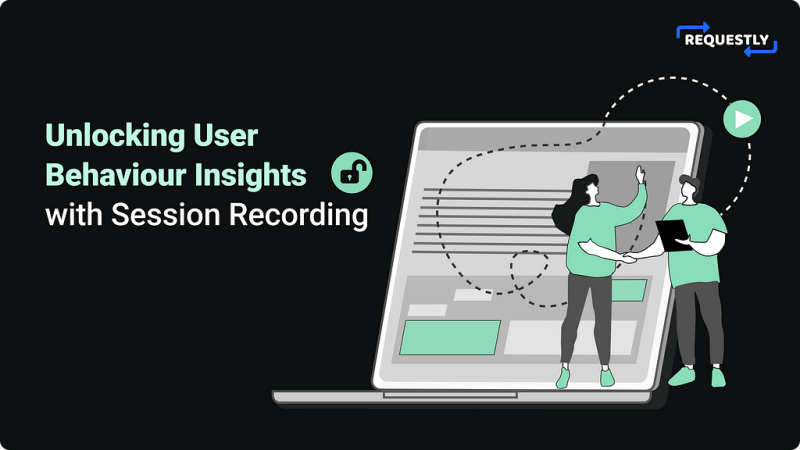Unlocking User Behaviour Insights with Session Recording
 Requestly
Requestly
Understanding user behaviour in modern business is of paramount importance as it provides valuable insights that can drive strategic decisions, enhance user experiences, and ultimately lead to business growth. By delving into the rhythms of user interactions, businesses can unearth invaluable insights that illuminate the path toward tailored solutions and resonant experiences. businesses can craft products, services, and interfaces that seamlessly align with users’ desires, leading to heightened engagement, loyalty, and brand affinity.
Here are some key points highlighting the importance of understanding user behaviour:
Tailored Marketing Strategies
One of the most potent advantages of delving into user behaviour lies in its ability to revolutionize marketing strategies. Armed with a comprehensive understanding of how users navigate and interact within the digital landscape, businesses can intricately tailor their marketing approaches. This intricate tailoring encompasses a multifaceted grasp of what users are actively seeking, their nuanced preferences, and the precise manner in which they engage with various types of content. By unravelling these intricate insights, businesses gain the capacity to craft marketing campaigns that extend far beyond generic approaches. The result is a harmonious resonance between the campaign’s messaging and the desires of the audience, fostering a connection that drives engagement and conversions.
Product and Service Improvement
The significance of user behaviour insights extends beyond the realm of marketing, deeply influencing the iterative enhancement of products and services. By meticulously analyzing how users interact with these offerings, businesses gain an invaluable wellspring of feedback that informs refinements and optimizations. This feedback-driven evolution is propelled by the identification of pain points, friction areas, and opportunities for enhancement that users encounter during their interaction with products or services.
Conversion Rate Optimization (CRO)
The transformative impact of comprehending user behaviour is particularly evident in the realm of Conversion Rate Optimization (CRO). This strategic approach hinges on dissecting the user journey through the conversion funnel, identifying bottlenecks and barriers that impede the seamless transition from a user’s initial interaction to a desired action — such as making a purchase or signing up. By delving into user behaviour data, businesses can navigate this journey with unprecedented precision. The data provides a roadmap of user interactions, shedding light on points of friction, moments of hesitation, and critical junctures where users frequently drop off.
What is Session Recording?
Session recording refers to the practice of capturing and recording user interactions with a digital application or website. It involves recording various elements of a user’s session, such as mouse movements, clicks, keystrokes, and screen views. Session recording is often utilized by businesses, developers, and UX/UI designers to gain insights into user behaviour, identify usability issues, and optimize the overall user experience. Session recording tools play a crucial role in achieving a comprehensive understanding of user behaviour. They allow you to visualize user interactions, see where they encounter difficulties, and observe their journey through your website or app. This real-time view into user sessions provides actionable insights that can be used to optimize user experiences, streamline processes, and address usability issues.
How Session Recording Works?
Session recording is typically implemented using specialized software or tools that track and record user interactions in real-time. These tools can be integrated into web or mobile applications through libraries or scripts. Here’s a simplified overview of how session recording works:
Data Collection: The session recording tool collects data as users interact with the application. This can include mouse movements, clicks, scrolls, form inputs, and other on-screen actions.
Data Transmission: The recorded data is transmitted securely to a centralized server or cloud-based storage for processing and analysis. This ensures that user data is handled responsibly and in accordance with privacy regulations.
Playback and Analysis: UX/UI designers, developers, and other stakeholders can access the recorded sessions for playback and analysis. They can watch the recorded sessions to understand user behaviour, pain points, and areas for improvement.
Insights and Optimization: The insights gathered from session recordings can be used to identify usability issues, optimize user flows, enhance design elements, and make informed decisions to improve the overall user experience.
Types of Data Captured
Session recording tools capture a wide range of data to provide a comprehensive view of user interactions. Some of the types of data captured during session recording include:
Mouse Movements and Clicks: Recording the path of the mouse cursor, clicks, and interactions with various on-screen elements.
Keystrokes: Capturing user keyboard inputs, including text entered into forms and search bars.
Scrolling Behaviour: Tracking how users navigate through content by scrolling.
Form Interactions: Recording how users fill out forms, select options, and submit data.
Page Views and Navigation: Monitoring the sequence of pages visited and the transitions between different sections of the application.
Errors and Alerts: Recording instances of error messages, pop-ups, and alerts encountered by users.
User Interfaces: Capturing the visual elements of the user interface, such as buttons, menus, and visual feedback.
Benefits of Using Session Recording for User Behaviour Analysis
Session recording serves as a powerful tool for unravelling the intricacies of user behaviour, providing a real-time visual window into how individuals interact with a website or application. This approach offers a multitude of benefits that enrich the understanding of user experiences and inform strategic decisions. Using session recording for user behaviour analysis offers several benefits that can significantly improve the usability and effectiveness of digital applications. Here are some key advantages:
Identifying User Pain Points: Session recording provides an invaluable opportunity to delve into the intricate landscape of your application, revealing nuanced user behaviours that might otherwise remain concealed. Instead of applying generic fixes or making assumptions about what needs improvement, you can now focus your efforts on these pinpointed pain points.
A/B Testing and Optimization: A/B testing stands as a cornerstone in the realm of data-driven decision-making, enabling you to refine and elevate your digital experiences with empirical precision. This method revolves around the meticulous comparison of two distinct renditions of a webpage or application, seeking to discern the superior performer in terms of user engagement, conversion rates, or other pertinent metrics.
Enhancing User Experience (UX): Understanding how users navigate your application, what features they engage with, and where they might be getting frustrated helps you make informed UX design decisions. By analyzing session recordings, you can refine user flows, streamline processes, and create more intuitive interfaces, ultimately leading to a more satisfying and enjoyable user experience. Through these recordings, you’re not just crunching numbers; you’re unravelling narratives. You can witness how users meander through different features, where they stumble, and where they flourish. It’s as if you’re virtually walking alongside them, sensing the pulse of their experience with each click, swipe, and scroll.
Best Practices for Implementing Session Recording:
Implementing session recording effectively requires a strategic approach that combines technical considerations with ethical guidelines. First and foremost, it’s crucial to clearly communicate to users that their interactions might be recorded, respecting their privacy and obtaining any necessary consent. Selective recording can help manage data volume while focusing on key user flows. Prioritizing data security is paramount; sensitive information must be appropriately masked or excluded.
Here are some best practices to consider:
Selecting the Right Tools:
Research and choose session recording tools that align with your needs, budget, and technical requirements. Consider factors such as data storage, security, playback capabilities, and integration with your existing analytics and UX tools.
Setting Clear Objectives:
Define specific goals for implementing session recording. What insights do you want to gain? What user behaviours or pain points are you trying to uncover? Establish key performance indicators (KPIs) that will help you measure the success of your session recording efforts.
Ensuring Compliance with Legal Regulations:
Ensure that your session recording practices comply with relevant privacy laws and regulations, such as GDPR, CCPA, or other local data protection laws. Obtain informed and explicit user consent before implementing session recording, especially if you’re recording personal or sensitive information.
By following these best practices, you can implement session recording in a way that respects user privacy, provides valuable insights, and contributes to the ongoing improvement of your digital applications.
Conclusion
Session recording offers valuable benefits, including identifying user pain points, facilitating A/B testing for optimization, enhancing UX design, recognizing behaviour patterns, mapping user journeys, conducting usability testing, troubleshooting bugs, and gauging user engagement. By leveraging session recordings, businesses can fine-tune their applications, improve user satisfaction, and drive more effective design decisions.
Implementing session recording effectively involves selecting the right tools aligned with your objectives, ensuring legal compliance and user consent, analyzing data with care, and balancing privacy concerns with actionable insights.
Originally published at https://requestly.com.
Subscribe to my newsletter
Read articles from Requestly directly inside your inbox. Subscribe to the newsletter, and don't miss out.
Written by
